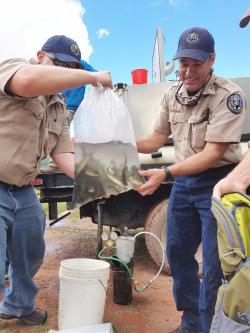 DURANGO, Colo. – Restoration of native trout reached another milestone on July 27 when 3,000 Colorado River cutthroat trout were stocked in streams about 30 miles north of Durango by Colorado Parks and Wildlife.
DURANGO, Colo. – Restoration of native trout reached another milestone on July 27 when 3,000 Colorado River cutthroat trout were stocked in streams about 30 miles north of Durango by Colorado Parks and Wildlife.
The restoration project is being done in the Hermosa Creek drainage and is a joint project of CPW and the San Juan National Forest, with assistance from Trout Unlimited. So far, restoration work has been completed on three phases of the project which includes sections of the main stem of Hermosa Creek and East Hermosa Creek. One more phase remains that will take two more years to complete.
Last week about 50 volunteers helped to distribute the five-inch fish in about three miles of water in East Hermosa Creek, Relay Creek and Sig Creek.
"Restoring native species is a high priority for Colorado Parks and Wildlife and the Hermosa Creek drainage is an ideal location for pure Colorado River cutthroat trout," said Jim White, CPW aquatic biologist in Durango who has coordinated the projects. "There are numerous tributaries streams that provide a variety of habitats and safe havens for populations in case of catastrophic events, such as fire, drought or disease."
To restore native fish, the U.S. Forest Service has built two barriers on the creeks which block the passage of non-native rainbow and brook trout. Native cutthroats cannot compete with those fish in a stream. Following construction of the barriers, CPW treated the water to kill all fish in the stream. Generally, it takes two years for biologists to confirm that all fish have been eliminated. After that, native fish can be restocked.
Besides building the barriers, the Forest Service has also made improvements along the streams to improve fish habitat.
Fish are doing well on the section completed five years ago on Hermosa Creek, White said. A recent survey showed that more than 400 fish per mile now inhabit the creek.
"We know the fish are reproducing in that section and we are very pleased with what we're seeing," White said.
The last phase of the project will connect East Hermosa Creek with the main stem. The Forest Service is currently building another barrier just below the confluence of the two streams; treating the water to eliminate all fish will be done in 2018 and 2019. By 2020, if all goes as planned, nearly 25 miles of stream in the Hermosa Creek drainage will be home to the native trout.
Hermosa Creek is an excellent spot for anglers to get off the beaten path for catch-and-release-fishing. Anglers are reminded that fishing in this area is by fly and lure only, and that all cutthroat trout caught in the area must be returned to the water immediately.
To learn more about CPW's work to restore native trout throughout the state, go to: http://cpw.state.co.us/learn/Pages/ResearchCutthroatTrout.aspx.
###
CPW is an enterprise agency, relying primarily on license sales, state parks fees and registration fees to support its operations, including: 42 state parks and more than 350 wildlife areas covering approximately 900,000 acres, management of fishing and hunting, wildlife watching, camping, motorized and non-motorized trails, boating and outdoor education. CPW's work contributes approximately $6 billion in total economic impact annually throughout Colorado.
Copyright © 2013-2025 WesternBass.com ®


 Advertising
Advertising